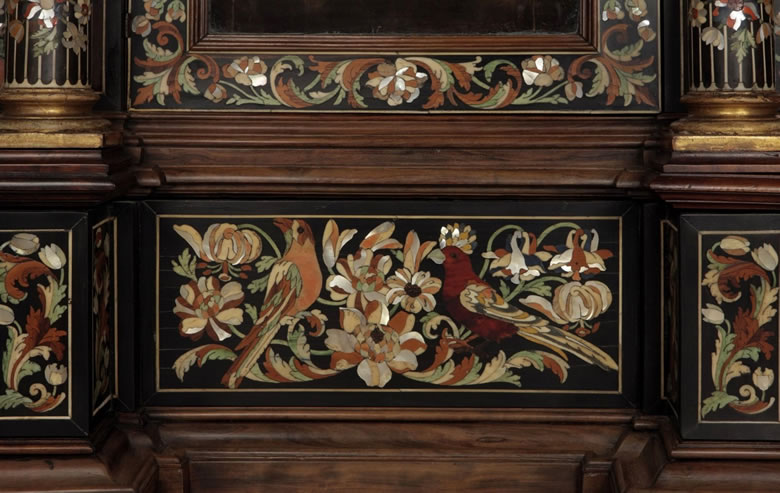Dalva Brothers Antiques, Antique Furniture, New YorkFrench 18th century furniture, clocks, lighting, paintings, porcelain, sculpture and tapestries |
| Rare Florentine baroque walnut, ebony, natural and stained bone, ivory and mother of pearl marquetry clock in the form of a façade with freestanding columns attributed to Leonard van der Vinne. The shaped plinth contains a drawer marquetried with birds, flowers and acanthus scrolls with protrusions supporting freestanding columns decorated with floral swags. Two volutes flank the movement that is located behind a glazed door framed with marquetry acanthus scrolls under an ivory balustrade. The sides are veneered in walnut and ebony. The early 18th century French movement, signed Baltasar Martinot AParis, probably replaces the original Italian night-clock movement. The interior back is mirrored to intensify an alcohol lamp’s light and there is an escape hole to allow the fumes to escape. The movement possibly was replaced in France in the 18th century. There is a record of an Italian movement being replaced by a French movement in an Italian clock case given to Louis XIV. [Missing pieces, replacements. Movement replaced.] A similar clock, nearly the same size, and with very similar marquetry is plate V in Alvar González-Palacios: Il Tempio del Gusto; Longanesi & C., Milan, 1968. It is described on page 34 and is attributed to the Botteghe granducali and the workers Leonardo van der Vinne and Andrea Scacciati. The Flemish master intarsiatore (inlay artist) and cabinet-maker moved to Italy and worked at the Botteghe granducali from 1659 until 1713. Another clock from the Grand Ducal workshops with a similar façade form, but with pietre dure intarsia is in the Rosalinde and Arthur Gilbert Collection at the Victoria & Albert Museum. That case has a replacement German movement installed in the 18th century. |
||
| Height (ins.): 33.5 (85cm) Length/Width (ins.): 29 (74cm) Depth (ins.): 10.75 (27cm) | ||
| Origin: Florence, Italy circa 1700 Period: Baroque | ||
|
|
||
|
||
| << Previous Page | ||




